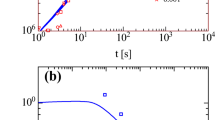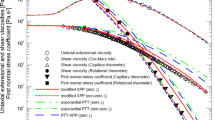Abstract
The linear and nonlinear steady-state viscosities and elastic compliances were measured in shear and elongational flows for two low-density polyethylenes, a linear polypropylene, and two metallocene catalyzed polyethylenes (one linear and one long-chain branched) by Wolff et al. (Rheol Acta 49:95–103, 2010) and Resch (dissertation, 2010). Comprehensive data of this type are rarely found in the literature, and comprehensive modeling of both viscous and elastic effects is even rarer. In this contribution, the reliability of a modeling approach proposed by Laun (J Rheol 30(3):459–501, 1986) and based on the damping function concept is tested. The strain hardening seen for the long-chain branched polymers and its absence in the case of the linear polymer, the stronger decrease of the tensile compliance in comparison to the shear compliance with increasing stress, as well as the extended linear-viscoelastic regime of the shear viscosity in contrast to the shear compliance are correctly modeled. While the modeling of the nonlinear response in shear can be achieved with only one material parameter for most of the polymers considered here, the nonlinear modeling in elongation is achieved with two parameters. The same parameter values are shown to describe viscous as well as elastic properties of the melts, and thus the relations of Laun can be used to test the consistency of viscosity and compliance measurements.






Similar content being viewed by others
References
Chen X, Stadler FJ, Münstedt H, Larson RG (2010) Method for obtaining tube model parameters for commercial ethane/α-olefin copolymers. J Rheol 54(2):393–406.
Dealy JM, Larson RG (2006) Structure and rheology of molten polymers from structure to flow behavior and back again. Hanser, Germany
Franck A, Meissner J (1984) The influence of blending polystyrenes of narrow molecular weight distribution on melt creep flow and creep recovery in elongation. Rheol Acta 23:117–123
Gabriel C, Kaschta J (1998) Comparison of different shear rheometers with regard to creep and creep recovery measurements. Rheol Acta 37:358–364
Gabriel C, Kaschta J, Münstedt H (1998) Influence of molecular structure on rheological properties of polyethylenes. I. Creep recovery measurements in shear. Rheol Acta 37:7–20
Gabriel C, Münstedt H (1999) Creep recovery behaviour of metallocene linear low-density polyethylenes. Rheol Acta 38:393–403
He C, Wood-Adams P, Dealy JM (2004) Broad frequency range characterization of molten polymers. J Rheol 48(4):711–724
Karam HJ, Bellinger JC (1964) Tensile creep of polystyrene at elevated temperatures. Part I. Trans Soc Rheol 8:61–72
Kaschta J, Schwarzl FR (1994a) Calculation of discrete retardation spectra from creep data—I. Method Rheol Acta 33(6):517–529
Kaschta J, Schwarzl FR (1994b) Calculation of discrete retardation spectra from creep data—II. Analysis of measured creep curves. Rheol Acta 33(6):530–541
Kessner U, Kaschta J, Münstedt H (2009) Determination of method-invariant activation energies of long-chain branched low-density polyethylenes. J Rheol 53(4):1001–1016
Kraft M, Meissner J, Kaschta J (1999) Linear viscoelastic characterization of polymer melts with long relaxation times. Macromolecules 32:751–757
Kurzbeck S, Oster F, Münstedt H (1999) Rheological properties of two polypropylenes with different molecular structure. J Rheol 43(2):359–374
Laun HM (1978) Description of the non-linear shear behaviour of a low density polyethylene melt by means of an experimentally determined strain dependent memory function. Rheol Acta 17:1–15
Laun MH (1986) Prediction of elastic strains of polymer melts in shear and elongation. J Rheol 30(3):459–501
Laun HM, Meissner J (1980) A sandwich-type creep rheometer for the measurement of rheological properties of polymer melts at low shear stresses. Rheol Acta 19:60–67
Laun HM, Münstedt H (1976) Comparison of the elongational behaviour of a polyethylene melt at constant stress and constant strain rate. Rheol Acta 15:517–524
Laun HM, Münstedt H (1978) Elongational behaviour of a low density polyethylene melt. I. Strain rate and stress dependence of viscosity and recoverable strain in the steady-state. Comparison with shear data. Influence of interfacial tension. Rheol Acta 17:415–425
Leblans PJR, Sampers J, Booij HC (1985) Rheological properties of some polyolefine melts in transient uniaxial elongational flow, described with a special type of constitutive equation. J Non-Newtonian Fluid Mech 19:185–207
Lohse DJ, Milner ST, Fetters LJ, Xenidou M, Hadjichristidis N, Mendelson RA, García-Franco CA, Lyon MK (2002) Well-defined, model long chain branched polyethylene. 2. Melt rheological behavior. Macromolecules 35:3066–3075
Malkin AY, Isayev AI (2006) Rheology. Concepts, methods and applications. ChemTec Publisching, Toronto
McLeish TCB, Larson RG (1998) Molecular constitutive equations for a class of branched polymers: the pom-pom polymer. J Rheol 42(1):81–110.
Meissner J (1972) Development of a universal extensional rheometer for the uniaxial extension of polymer melts. Trans Soc Rheol 16(3):405–420
Münstedt H (1975) Viscoelasticity of polystyrene melts in tensile creep experiments. Rheol Acta 14:1077–1088
Münstedt H, Laun HM (1981) Elongational properties and molecular structure of polyethylene melts. Rheol Acta 20(3):211–221
Nemoto N (1970) Viscoelastic properties of narrow-distribution polymers II. Tensile creep studies of polystyrene. Polym J 1(4):485–492
Patham B, Jayaraman K (2005) Creep recovery of random ethylene-octene polymer melts with varying comonomer content. J Rheol 49(5):989–999
Resch JA (2010) Elastic and viscous properties of polyolefin melts with different molecular structures investigated in shear and elongation. Dissertation, Universität Erlangen-Nürnberg
Resch JA, Stadler FJ, Kaschta J, Münstedt H (2009) Temperature dependence of the linear steady-state shear compliance of linear and long-chain branched polyethylenes. Macromolecules 42:5676–5683
Rolón-Garrido VH, Pivokonsky R, Filip P, Zatloukal M, Wagner MH (2009) Modelling elongational and shear rheology of two LDPE melts. Rheol Acta 48:691–697
Rolón-Garrido VH, Wagner MH (2009) The damping function in rheology. Rheol Acta 48:245–284
Sentmanat M, Wang BN, McKinley GH (2005) Measuring the transient extensional rheology of polyethylene melts using the SER universal testing platform. J Rheol 49(3):585–606
Simhambhatla M, Leonov AI (1995) On the rheological modelling of viscoelastic polymer liquids with stable constitutive equations. Rheol Acta 34:259–273
Stadlbauer M, Janeschitz-Kriegl H, Lipp M, Eder G, Forstner R (2004) Extensional rheometer for creep flow at high tensile stress. Part I. Description and validation. J Rheol 48(3):611–629
Termonia Y (1996) A creep compliance simulation study of the viscosity entangled polymer melts. Macromolecules 29:2025–2028
Vinogradov GV, Fikhman VD, Radushkevich BV (1972). Uniaxial extension of polystyrene at true constant stress. Rheol Acta 11:286–291
Wagner MH (1976) Analysis of time-dependent non-linear stress-growth data for shear and elongational flow of a low-density branched polyethylene melt. Rheol Acta 15:136–142
Wagner MH (1978) A constitutive analysis of uniaxial elongational flow data of a low-density polyethylene melt. J Non-Newton Fluid Mech 4:39–55
Wagner MH (1979) Elongational behaviour of polymer melts in constant elongation-rate, constant tensile stress, and constant tensile force experiments. Rheol Acta 18(6):681–692
Wagner MH, Stephenson SE (1979) The irreversibility assumption of network disentanglement in flowing polymer melts and its effects on elastic recoil predictions. J Rheol 23(4):489–504
Wagner MH, Meissner J (1980) Network disentanglement and time-dependent flow behaviour of polymer melts. Makromol Chem 181:1533–1550
Wagner MH, Rubio P, Bastian H (2001) The molecular stress function model for polydisperse polymer melts with dissipative convective constraint release. J Rheol 45:1387–1412
Watanabe H, Inoue T (2004) Creep behavior of combined Rouse-reptation mechanism. Nihon Reoroji Gakkaishi (J Soc Rheol Jpn) 32(3):113–116
Winter HH, Mours M (2007) Iris Developments. http://rheology.tripod.com/
Wolff F, Resch JA, Kaschta J, Münstedt H (2010) Comparison of viscous and elastic properties of polyolefin melts in shear and elongation. Rheol Acta 49:95–103
Yasuda S, Yamamoto R (2010) Multiscale modelling and simulation for polymer melt flows between parallel plates. Phys Rev E 81:036308
Acknowledgements
Financial support by the German Science Foundation (DFG) is gratefully acknowledged.
Author information
Authors and Affiliations
Corresponding author
Rights and permissions
About this article
Cite this article
Rolón-Garrido, V.H., Resch, J.A., Wolff, F. et al. Prediction of steady-state viscous and elastic properties of polyolefin melts in shear and elongation. Rheol Acta 50, 645–653 (2011). https://doi.org/10.1007/s00397-011-0546-1
Received:
Revised:
Accepted:
Published:
Issue Date:
DOI: https://doi.org/10.1007/s00397-011-0546-1




